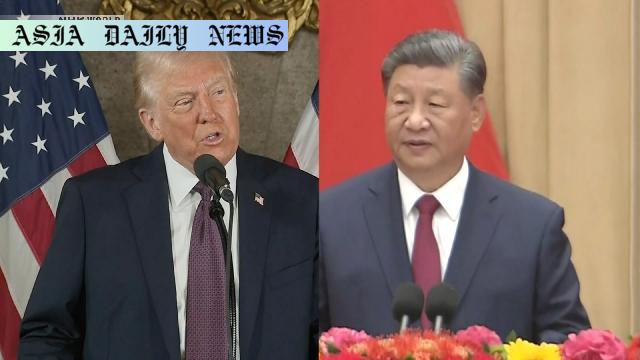Tariffs: China urges dialogue with the US to address trade disputes amidst escalating tensions over reciprocal tariffs.
China has called for dialogue with the US to manage escalating trade disputes.
China and the US are imposing reciprocal tariffs on each other’s key imports.
China criticizes the US approach, urging respect and mutual negotiations.
US postal restrictions on Chinese parcels add friction to ongoing issues.

Escalating Trade Tensions Between China and the US
Recent developments around the US-China trade dispute have once again captured global attention. On Tuesday, the United States administration under President Trump announced the imposition of an additional 10 percent tariffs on a variety of Chinese goods—marking another chapter in the ongoing trade battle between the two nations. In response, China has retaliated with tit-for-tat tariffs on US exports, including coal and liquefied natural gas, to be enforced starting Monday. This escalation has raised concerns about the broader implications for global trade and economic stability.
China Urges Dialogue Over Unilateral Actions
China’s Foreign Ministry spokesperson, Lin Jian, addressed these developments during a recent press conference. Lin pointed out that pressure and threats have historically shown limited effectiveness against China, emphasizing the need for dialogue rooted in mutual respect and equal footing. He strongly criticized the United States’ approach of imposing unilateral tariffs, calling instead for negotiations that could create a more balanced trade relationship. The underlying message from China appears to be a desire for fairness and the avoidance of prolonged conflict.
Consequences of the Tariff Clash
The reciprocal nature of these tariffs has far-reaching economic and logistical implications. For the United States, China’s tariffs on goods like coal and liquefied natural gas could disrupt supply chains and make American products less competitive in a key market. Conversely, Chinese exports subject to US tariffs, including consumer goods, might face decreased demand due to higher prices. Such measures have the potential to harm businesses and consumers in both nations, while rippling outwards to impact global markets tied to these economies.
Other Developments: US Postal Restrictions on Chinese Parcels
A surprising announcement by the United States Postal Service has added another layer of complexity to the trade dispute. The USPS declared it would temporarily stop accepting parcels from China and Hong Kong, citing the imposition of additional tariffs as a key factor. While the exact implications of this move are still unfolding, it signifies growing friction in economic and logistical exchanges between the two countries.
Larger Geopolitical Implications
The ongoing tariff battle has also brought geopolitical considerations into sharper focus. Questions about the long-term implications of strained US-China relations are driving discussions around trade strategy, cooperation, and competition. Both nations are major global players whose decisions ripple across the world. Analysts are carefully observing whether dialogue can emerge to de-escalate tensions or if both nations will persist in their hardened stances.
Path Forward: Possibilities for Resolution
Despite the heated exchanges, signals from US sources suggest potential high-level communications between President Trump and Chinese President Xi Jinping could occur soon. Such discussions could provide an avenue for addressing core grievances on both sides, potentially easing tensions. However, the lack of specific timing for these talks underscores the difficulty of reaching consensus on complex trade and policy matters.
Call for a Balanced Approach
China’s appeal for mutual respect and willingness to engage in dialogue signals a preference for constructive solutions over prolonged conflict. However, differing priorities, domestic pressures, and economic strategies make achieving a balanced resolution more complex. The road ahead remains uncertain, requiring significant diplomatic efforts and compromise from both nations.
As trade tensions continue to dominate headlines, their impact on global markets, supply chains, and diplomatic relations will undoubtedly remain key points of discussion in the coming months.



Commentary
Understanding the Escalation of US-China Trade Tensions
The recent news of escalating tariffs between the United States and China highlights just how intertwined the global economy has become—and how fragile these connections can be in times of political or economic discord. While tariffs are heralded by supporters as a tool to protect domestic industries, their broader repercussions often paint a different picture. In this case, both the US and China are feeling the direct and indirect impacts of these trade measures, from disrupted supply chains to uneasy market reactions.
Importance of Dialogue in a Complex Landscape
China’s appeal for dialogue suggests that, behind public confrontations, there is still room for reconciliation. This is vital not just for the two nations involved, but also for the global community that relies on efficient trade flows and stable relations between major powers. However, the success of such negotiations will depend on whether both sides can put aside political posturing in favor of meaningful compromises and long-term planning.
The Role of Leadership in De-escalating Disputes
At a time like this, leadership plays a critical role in shaping outcomes. Both President Trump and President Xi Jinping are expected to make decisions that could mark a turning point in this dispute. High-level communication, if it occurs, may offer an opportunity to navigate out of this impasse. For those of us observing from the sidelines, it remains a test of diplomatic acumen and foresight, as both leaders are balancing domestic interests with the need for international stability.
Ultimately, the hope is that reason and mutual respect will guide US-China relations toward a more balanced future. In moments of heightened tension, collaboration—even if difficult—can pave the way toward more equitable solutions.